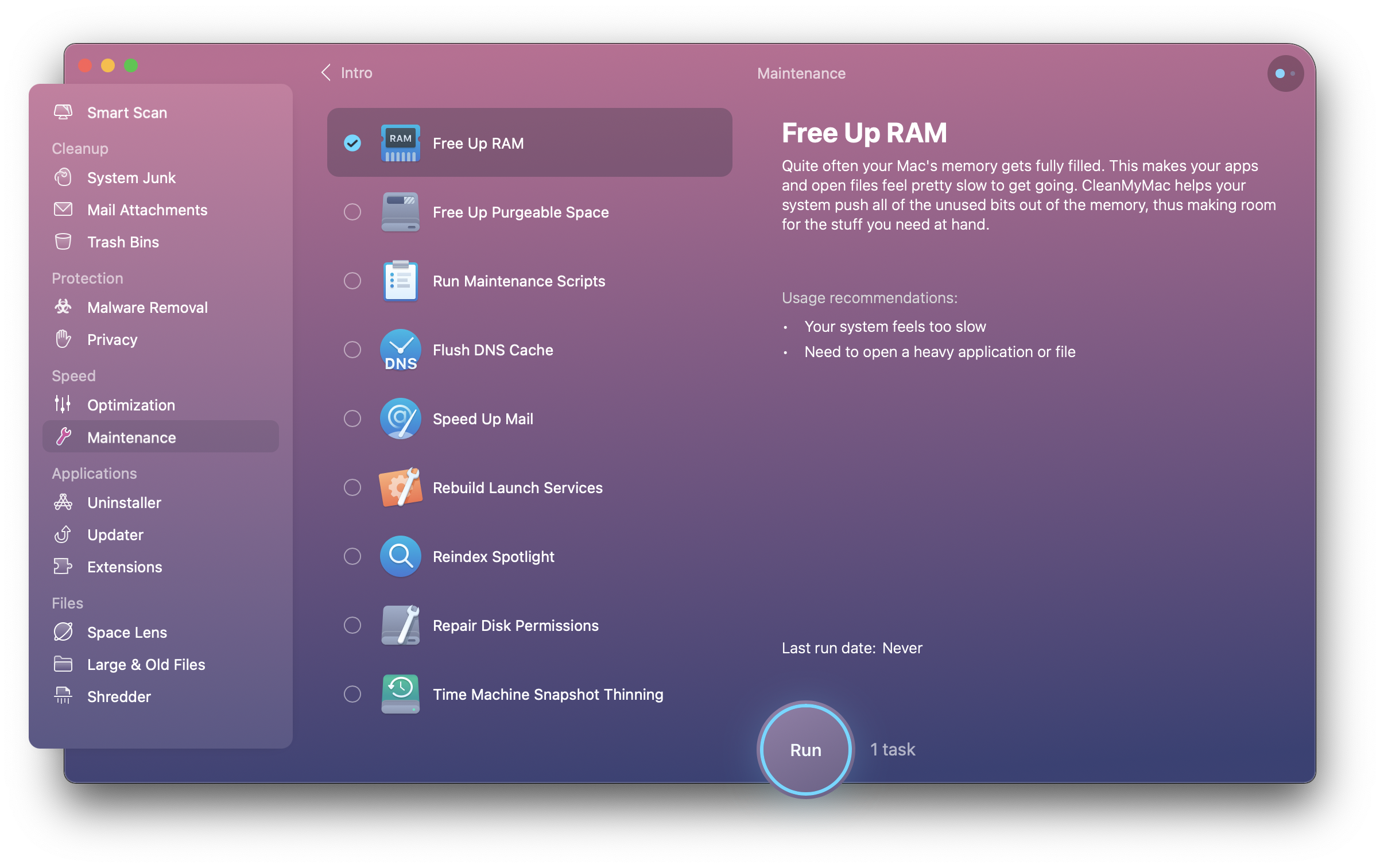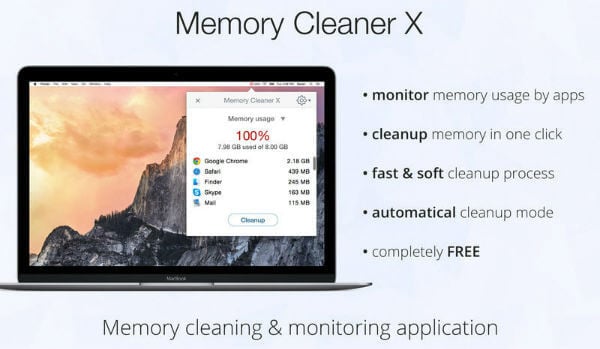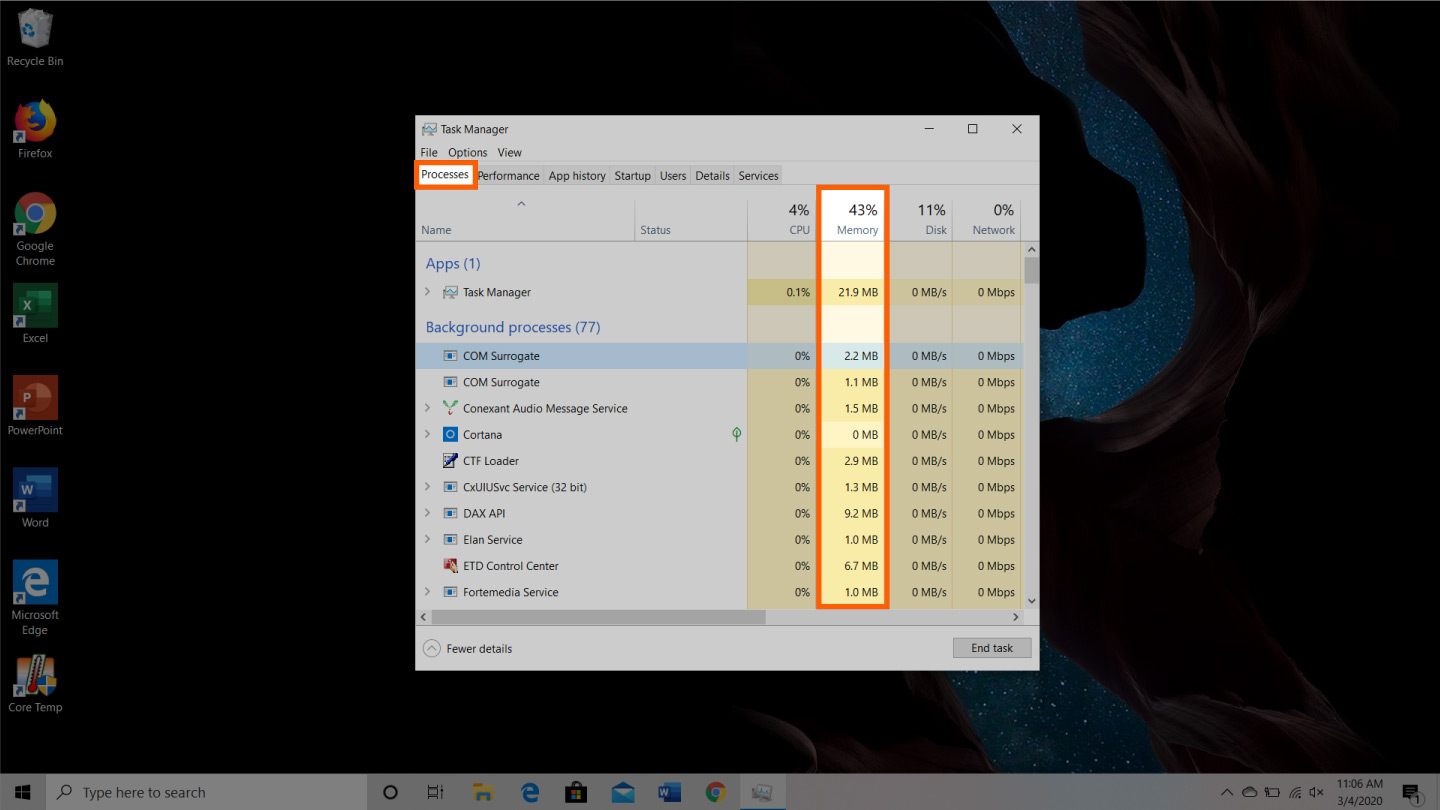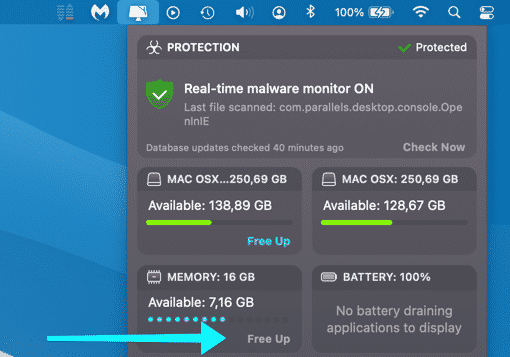Just like any day-to-day item, your Mac needs a good cleaning once in a while. Getting rid of all the unnecessary files will help your Mac return to its factory excellence and speed up to match your needs. However, you might find yourself clueless as to where to start your Mac clean up: what can be deleted and what should be left on drive? Don’t worry. You might be a little bit lost right now but, as usual, we have some bulletproof tips and tools to help you clean your Mac and speed it up.
Mac cleaning tools provided in the Toolbox that could also be useful when cleaning a Mac include: Clean Drive, Uninstall Apps, Find Duplicates, Free Memory. Parallels says the Clean Drive tool will. A window will pop up confirming you want to delete the files and asking you for your Mac’s password. Image: Screenshot: Kristin Wong Once you enter your password, Mac will clear your cache. It targets to speed up your Mac by releasing memory. It presents both Free and Used memory information. Once clicking the Clean button at the bottom center part of the window, you will get more available memory to start your applications faster. However, you are not recommended to release it frequently. In this tutorial we will show you how to easily clean the Cache memory on MAC OSX (Mac OS / MacOS / Mac OSX) in order to speed it up and free up some space.
4 steps to Mac cleanup
The good news is that in four (or even less) steps you can get a cleaner Mac and boost your Mac’s performance.
If your Mac is out of storage space or starts running slow, you’re up for a cleaning game. And you don’t have to do it alone. We’ve prepared the smartest memory-boosting hacks and practices to speed of your Mac safely. Time for an easy Mac cleanup!
Clean up your Mac’s Desktop
This might seem like an obvious step to take, but you’d be surprised how many Mac users believe the Desktop is the perfect place to store files and docs, handy and always on tap. However, that’s a rookie mistake. Fortunately, you can fix it. That’s why you should clean your Mac starting from the Desktop before you go any deeper. Be honest, can you even see your desktop background clearly now or is it obscured because of the icon-riddled mess?
The fact is, that the Finder treats any folder or file on your desktop as a window. A couple of items on the desktop cause no problem, but if the clutter persists, your Finder will soon slow down and get on your nerves. So better sort it all out to separate folders and let us quickly take you to number two.
Free up your Mac’s hard drive
When it comes to storage, there are items you know about (like your photos and videos) and many hidden entities (like cache files, logs, and app junk). These deep-seated junk files may start off small, but over time they will begin to weigh your Mac down.
Tip: According to one test conducted by MacWorld, nearly full hard drives perform 17.5% slower than the cleaner ones. That’s why it’s so important to refresh your hard drive every now and then. Your system will convert the newly-released free space into virtual memory to ensure your apps are running smoothly. Otherwise, if you’re low on space, your Mac will slow down.
One folder you should regularly clean up for a faster Mac is the Downloads folder. This is where junk piles up little by little, resulting in a total mess. For a complete Mac clean up, make sure to also ditch any unnecessary widgets or apps. Wait, but you think you might need them one day? Truth is, if you haven’t used them so far, you won’t use them in the future. So gather all your courage and hit Delete.
If your Mac is still running slow, then it could be due to old hardware. A new SSD or more RAM is the easiest way to boost your hardware performance without having to spend too much.
How do I know what to delete?
What’s really annoying is that some massive folders on your Mac remain invisible. Each app or website visit leaves behind its own archive of data, which keeps growing over time. To hack this, you can use CleanMyMac X app by MacPaw. It uncovers large redundant files you can delete. And this application is notarized by Apple.
You can delete:
broken downloads
remains of old apps
outdated cache
It found 5.81 GB on our computer, but it may detect even more on your Mac.
Download Free VersionTake control of startup and login items
When your Mac boots up, the macOS will launch various startup items. Some you do need, but nearly half of them can be safely switched off. Otherwise, they’ll sit in the background using up your system resources and slowing your Mac down.
To remove startup and login items manually, go to System Preferences > Users & Groups and click on your username. Next up, click on “Login Items” and select all the apps you don’t need running at startup. Then click the “-” button below and you’re done. By disabling the startup programs, you’ll have a speedier Mac next time you boot up.
Repair disk permissions
Disk permissions act like doorkeepers preventing third-party apps from meddling with your system. But disk permissions can get broken, which limits your Mac ability to find the right files.
If you’re on El Capitan or older OS X versions, you can repair disk permissions using the following command in the Terminal window:
sudo /usr/libexec/repair_packages --verify --standard-pkgs /
It will now check the validity of your disk permissions. If you get anything saying “permissions differ”, then you can fix it with this command:
sudo /usr/libexec/repair_packages --repair --standard-pkgs -- volume /

If you are a mere mortal, uneasy with using Terminal, a Mac cleaning utility like CleanMyMac X, can do a better, risk-free job. A single click in Maintenance > Repair Disk Permissions solves it without fuss. With your disk permissions fixed and verified you can enjoy a smoother overall Mac experience.
The free version of this tool is available for download here.
Once you’ve finished to clean up your Mac, make sure to reboot your machine for a fresh start.
Delete System Junk and browser cache
System Junk can account for significant amount of disk space. It’s a broad term that describes temporary files created by your OS itself and all your apps. Since we mostly use our Macs to go online, the internet-related junk takes up the most space.
How to clean up your browser cache:
For Safari, click Develop in the top menu
Then, click Empty caches
For Chrome, click the “hamburger” icon in the top right corner
Then click More tools > Clear browsing data
Find hidden files on your drive
You probably know that a lot of files are purposely made invisible on your Mac. Not necessarily with bad intentions. Such files could be crucial system components and thus protected from accidental deletion. Quite often, however, you’ll encounter remains of old apps, invisible adware, and extensions.
There is a shortcut key combination to reveal the unseen files.
Go to your Documents, or any other directory
Click Shift +Command + Period key
Do you see any grayed out files? Check what these files are and delete them if they look suspicious.
Remove old backups (and Time Machine backups)
There are several layers of backups built in your macOS. Local Time Machine snapshots, iOS, and iCloud backups, etc. If we’re talking about a clean Mac, that’s free from old baggage, you should look into removing them too.
Here is how to remove local Time Machine backups (a.k.a snapshots)
Click Launchpad and type in Time Machine
Your backups will be broken by locations, like Desktop. You can use arrows to the right to navigate between past states of that location.
Now, click on the gear icon in the menu above.
Select “Delete All Backups” in the menu.
Delete the iCloud backups stored on your Mac
How To Clean Up Application Memory On Mac Air
Open System Preferences > iCloud.

Click Manage... at the bottom the pane.
Look through the list of iCloud backups in the sidebar.
iCloud photos will probably occupy the most space. If you’re ready to say goodbye to them, click Delete.Build the map of your storage
Any computer is ultimately a tree of folders. What if you could draw the map of all folders you have on your Mac and see how large these folders are?
Apparently, there is an ultra simple way to do it. Some applications like Daisy Disk or CleanMyMac will build such “folder tree” for you and it’s really fascinating to look at.
For example, this is the Space Lens tool from CleanMyMac X:
Download Free VersionThe blue bubbles stand represent my folders big and small. You can dive into each folder exploring your drive in a completely new way, much more informative than using the Finder. You can find your long lost folders and locate your biggest space wasters.
To use this tool, download the app (see the button above)
Click the Space Lens tab in the sidebar
Clean your Mac the smart way, all the way
If you’ve been following the steps above (and read some extra tips), you are fully equipped to clean up your Mac. Because you don’t need to be a bearded IT guy to do it. Let alone spend extra cash to improve your Mac’s performance. Simply cleaning your system as steps above suggest or using a dedicated app like CleanMyMac will help you out. By the way. CleanMyMac is free to download, so give it a try. And see your Mac’s capabilities now, when it it’s not weighed down by junk.
Optimised Storage helps you save storage space by storing your content in iCloud and making it available on demand:
- When storage space is needed, files, photos, films, email attachments and other files that you rarely use are stored in iCloud automatically.
- Each file stays exactly where you last saved it, and will download when you open it.
- Files that you’ve used recently remain on your Mac, along with optimised versions of your photos.

If you haven't yet upgraded to macOS Sierra or later, find out about other ways to free up storage space.
Find out how much storage is available on your Mac
Choose Apple menu > About This Mac and then click Storage. Each segment of the bar is an estimate of the storage space used by a category of files. Move your pointer over each segment for more detail.

Click the Manage button to open the Storage Management window, pictured below.
Manage storage on your Mac
The Storage Management window offers recommendations for optimising your storage. If some recommendations have already been turned on, you will see fewer recommendations.
Store in iCloud
Click the Store in iCloud button and then choose from these options:
- Desktop and Documents. Store all files from these two locations in iCloud Drive. When storage space is needed, only the files you recently opened are kept on your Mac, so that you can work offline easily. Files only stored in iCloud will display a download icon , which you can double-click to download the original file. Find out more about this feature.
- Photos. Store all original, full-resolution photos and videos in iCloud Photos. When storage space is needed, only space-saving (optimised) versions of photos are kept on your Mac. To download the original photo or video, just open it.
- Messages. Store all messages and attachments in iCloud. When storage space is needed, only the messages and attachments you recently opened are kept on your Mac. Find out more about Messages in iCloud.
Storing files in iCloud uses the storage space in your iCloud storage plan. If you reach or exceed your iCloud storage limit, you can either buy more iCloud storage or make more iCloud storage available. iCloud storage starts at 50 GB for $0.99 (USD) a month, and you can purchase additional storage directly from your Apple device. Find out more about the prices in your region.
Optimise Storage
Click the Optimise button to save space by automatically removing films and TV programmes you've watched. When storage space is needed, films or TV programmes that you've purchased from Apple and have already watched will be removed from your Mac. Click the download icon next to a film or TV programme to download it again.
Your Mac will also save space by only keeping recent email attachments on this Mac when storage space is needed. You can manually download any attachments at any time by opening the email or attachment, or saving the attachment to your Mac.
Optimising storage for films, TV programmes and email attachments doesn't require iCloud storage space.
Empty Bin Automatically

Empty Bin Automatically permanently deletes files that have been in the Bin for more than 30 days.
Reduce Clutter
Reduce Clutter helps you identify large files and files you may no longer need. Click the Review Files button and then choose any of the file categories in the sidebar, such as Applications, Documents, Music Creation or Bin.
You can delete the files in some categories directly from this window. Other categories show the total storage space used by the files in each app. You can then open the app and decide whether to delete files from within it.
Find out how to re-download apps, music, films, TV programmes and books.
Where to find the settings for each feature
The button for each recommendation in the Storage Management window affects one or more settings in other apps. You can also control these settings directly within each app.
- If you're using macOS Catalina or later, choose Apple menu > System Preferences, click Apple ID, and then select iCloud in the sidebar: Store in iCloud turns on the Optimise Mac Storage setting on the right. To turn off iCloud Drive entirely, deselect iCloud Drive.
- If you're using macOS Mojave or earlier, choose Apple menu > System Preferences, click iCloud, then click Options next to iCloud Drive. Store in iCloud turns on the Desktop & Documents Folders and Optimise Mac Storage settings.
- In Photos, choose Photos > Preferences and then click iCloud. Store in iCloud selects iCloud Photos and Optimise Mac Storage.
- In Messages, choose Messages > Preferences, then click iMessage. Store in iCloud selects Enable Messages in iCloud.
- If you're using macOS Catalina or later, open the Apple TV app, choose TV > Preferences from the menu bar, then click Files. Optimise Storage selects “Automatically delete watched films and TV programmes”.
- In you're using macOS Mojave or earlier, open iTunes, choose iTunes > Preferences from the menu bar, then click Advanced. Optimise Storage selects “Automatically delete watched films and TV programmes”.
- In Mail, choose Mail > Preferences from the menu bar and then click Accounts. In the Account Information section on the right, Optimise Storage sets the Download Attachments menu to either Recent or None.
Empty Bin Automatically: From the Finder, choose Finder > Preferences, then click Advanced. Empty Bin Automatically selects “Remove items from the Bin after 30 days”.
Other ways that macOS automatically helps to save space
With macOS Sierra or later, your Mac will take these additional steps automatically to save storage space:
Free Computer Memory Clean Up
- Detects duplicate downloads in Safari, keeping only the most recent version of the download
- Reminds you to delete used app installers
- Removes old fonts, languages and dictionaries that aren't being used
- Clears caches, logs and other unnecessary data when storage space is needed
How to free up storage space manually
Even without using the Optimised Storage features described in this article, you can take other steps to make more storage space available:
- Music, films and other media can use a lot of storage space. Find out how to delete music, films and TV programmes from your device.
- Delete other files that you no longer need by moving them to the Bin, then emptying the Bin. The Downloads folder is good place to look for files that you may no longer need.
- Move files to an external storage device.
- Compress files.
- Delete unneeded email: In the Mail app, choose Mailbox > Erase Junk Mail. If you no longer need the email in your Deleted Items mailbox, choose Mailbox > Erase Deleted Items.
How To Clean Up My Memory On Macbook Pro
Learn more
How To Clean My Mac
- The Storage pane of About This Mac is the best way to determine the amount of storage space available on your Mac. Disk Utility and other apps may show storage categories, such as Not Mounted, VM, Recovery, Other Volumes, Free or Purgeable. Don't rely on these categories to understand how to free up storage space or how much storage space is available for your data.
- When you duplicate a file on an APFS-formatted volume, that file doesn't use additional storage space on the volume. Deleting a duplicate file only frees up the space required by any data that you might have added to the duplicate. If you no longer need any copies of the file, you can recover all of the storage space by deleting both the duplicate and the original file.
- If you're using a pro app and Optimise Mac Storage, find out how to make sure your projects are always on your Mac and able to access their files.




